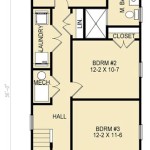Shipping Container Home Floor Plans: Maximizing Space and Design
Shipping container homes have gained significant popularity as an alternative housing solution, offering a blend of affordability, sustainability, and design flexibility. The core of any shipping container home project resides in the floor plan. A well-designed floor plan is essential to maximizing the limited space, ensuring functionality, and creating a comfortable living environment. This article provides an overview of key considerations and options when designing a shipping container home floor plan.
Understanding Standard Shipping Container Dimensions
Before delving into specific floor plan ideas, it is imperative to understand the standard dimensions of shipping containers. The most commonly used sizes are 20-foot and 40-foot containers. A standard 20-foot container typically measures 20 feet long, 8 feet wide, and 8.5 feet high. A 40-foot container maintains the same width and height but doubles the length. High cube containers, which offer an extra foot of height (9.5 feet total), are also available and can significantly impact the overall feel of the space, especially in areas prone to claustrophobia or specific design needs like lofted bed frames.
These dimensions serve as the foundation for the floor plan. It is crucial to account for wall thickness, insulation, and interior finishes, as these will reduce the usable interior space. A 20-foot container will likely offer approximately 160 square feet of living space, while a 40-foot container will provide around 320 square feet. These limitations dictate the approach to floor plan design.
Key Considerations in Shipping Container Home Floor Plan Design
Designing a shipping container home floor plan requires careful consideration of several factors. The limited space necessitates prioritizing functionality and efficient space utilization. Practicality, aesthetics, and compliance with local building codes are all crucial elements.
Space Optimization: Every square foot counts. Multi-functional furniture, such as sofa beds, folding tables, and storage beds, is essential. Open floor plans that integrate living, dining, and kitchen areas can create a sense of spaciousness. Vertical space should be maximized with shelving, lofted beds, and tall cabinets. Incorporating built-in storage solutions helps to minimize clutter and maximize usable floor area.
Natural Light and Ventilation: Shipping containers can feel dark and stuffy without proper light and ventilation. Strategically placed windows and doors are vital. Skylights can also be added to bring in natural light. Consider the orientation of the container on the property to maximize sunlight exposure. Cross-ventilation, where windows are placed on opposite sides of the container, is crucial for airflow, particularly in warmer climates. Ensure windows and doors are properly insulated to prevent heat loss or gain.
Plumbing and Electrical Systems: Planning the plumbing and electrical systems early in the design process is vital. Consider the placement of bathrooms, kitchens, and laundry areas, as these will require plumbing connections. Electrical wiring needs to be concealed and protected within the walls. It is essential to consult with qualified plumbers and electricians to ensure that these systems are installed safely and in compliance with local codes. Waste and water lines must be properly run underneath or within the walls and floors, depending on the foundation type.
Insulation and Climate Control: Shipping containers are made of steel, which conducts heat and cold efficiently. Adequate insulation is essential to maintaining a comfortable indoor temperature. Spray foam insulation, rigid foam boards, and batt insulation are common options. Consider the climate when selecting insulation materials and R-values (a measure of thermal resistance). Heating and cooling systems, such as mini-split systems or window units, will be necessary to regulate the temperature. Proper insulation is not only about comfort but also about minimizing energy consumption and reducing utility costs.
Structural Integrity: Modifying a shipping container can compromise its structural integrity. Cutting large openings for windows or doors requires reinforcement to maintain the container's strength. Consult with a structural engineer to ensure that any modifications are structurally sound. Stacking containers also requires careful consideration of the load-bearing capacity. The corners of the containers are the strongest points, and any structural modifications should be designed to distribute the load appropriately.
Building Codes and Regulations: Before starting any construction, research and comply with all applicable local building codes and regulations. Some municipalities may have specific requirements for shipping container homes, including zoning restrictions, foundation requirements, and insulation standards. Obtaining the necessary permits is crucial to avoid potential legal issues and ensure that the home is safe and habitable.
Common Shipping Container Home Floor Plan Options
The flexibility of shipping container architecture allows for diverse floor plan designs. The following are some common floor plan options, categorized by the number of containers used.
Single Container Homes: Single container homes are ideal for minimalist living or as accessory dwelling units (ADUs). Floor plans typically include a combined living area/bedroom, a small kitchenette, and a bathroom. Efficient space utilization is crucial. Examples include:
* Studio Apartment: A simple open-plan layout with a bed, small seating area, kitchenette along one wall, and a bathroom at the opposite end.
* Tiny Home with Loft: Utilizing vertical space, a lofted bed can free up floor space for a more spacious living area. The bathroom and kitchenette are typically located beneath the loft.
* Office/Studio Space: Single containers can be converted into functional office or studio spaces, ideal for remote workers or artists. The layout can be customized to include desks, storage, and work areas.
Two-Container Homes: Combining two containers opens up possibilities for more elaborate floor plans. The containers can be placed side-by-side, end-to-end, or stacked.
* Linear Layout: Two containers placed end-to-end can create a long, narrow home with separate living and sleeping areas. A living room, kitchen, and dining area can be located in one container, while the bedroom and bathroom are located in the other.
* Side-by-Side Layout: Placing two containers side-by-side allows for a wider living space. This configuration is ideal for creating an open-concept living area with a kitchen island or a larger bathroom. Joining the containers requires cutting through the side walls and reinforcing the structure.
* Stacked Layout: Stacking two containers can create a two-story home. This configuration requires careful structural planning and reinforcement. The lower level can house the living areas, while the upper level can be used for bedrooms.
Multi-Container Homes: Using three or more containers unlocks even greater design possibilities. These homes can be customized to include multiple bedrooms, bathrooms, and living spaces. Complex layouts are possible by combining different container orientations and configurations.
* L-Shaped Design: Three containers can be arranged in an L-shape to create a courtyard or outdoor living space. This design provides a clear separation between living and sleeping areas.
* U-Shaped Design: Three containers can be arranged in a U-shape to create a larger courtyard. This design is ideal for families who enjoy outdoor living.
* Multiple-Story Structures: Multiple containers can be stacked and arranged to create larger, multi-story homes. This requires careful structural engineering and design. Openings between containers can be used to create balconies or patios.
Software and Tools for Designing Shipping Container Home Floor Plans
Several software and tools can aid in the design of shipping container home floor plans. These tools range from simple online floor plan creators to professional-grade CAD software.
Online Floor Plan Creators: These user-friendly tools allow users to create basic floor plans with drag-and-drop functionality. They often include pre-designed furniture and fixtures that can be added to the plan. Examples include:
* Floorplanner: A web-based tool that allows users to create 2D and 3D floor plans. * RoomSketcher: Another popular option that offers a free version with limited features. * Planner 5D: A tool that focuses on creating visually appealing 3D renderings of floor plans.
CAD Software: Computer-Aided Design (CAD) software provides more advanced design capabilities. These programs allow users to create detailed plans, including structural details, plumbing layouts, and electrical schematics. Examples include:
* AutoCAD: An industry-standard CAD software used by architects and engineers. * SketchUp Pro: A 3D modeling software that is user-friendly and suitable for architectural design. * Revit: A Building Information Modeling (BIM) software that allows for comprehensive design and documentation.
3D Rendering Software: Software programs specializing in 3D rendering allow users to visualize the finished product. These programs can generate realistic images and animations of the floor plan, providing a better understanding of the space. Examples include:
* Lumion: A popular rendering software used by architects and designers. * V-Ray: A rendering engine that can be integrated with various CAD and 3D modeling programs.
Designing a shipping container home requires a careful balance of creativity, practicality, and technical knowledge. Understanding the standard dimensions of shipping containers, considering key design factors, and utilizing appropriate software tools are essential steps in creating a functional and aesthetically pleasing living space. Consulting with qualified professionals, such as architects, engineers, and contractors, will ensure that the project is structurally sound, compliant with local codes, and meets the specific needs of the homeowner. The careful execution of these steps will result in a unique and sustainable home that maximizes the potential of shipping container architecture.

Container Home Floor Plans Types Examples Considerations Cedreo

9 Container Home Floor Plans That Maximize Space House

Container Home Floor Plans Structures Layouts More Ideas

20 Foot Container Home Floor Plans

Container Home House Plans Cargo Best Ing 4 Bedroom 3x40 Foot Containers

20 Foot Container Home Floor Plans

Container Concept Blueprint Plans For 3 Building A Home House

Gallery Of Container House Studio H T 9

View All Floor Plans Custom Container Living

Container Home Floor Plans And Design Ideas My Conex








